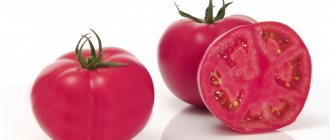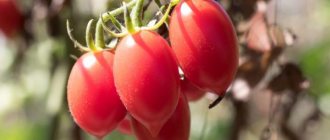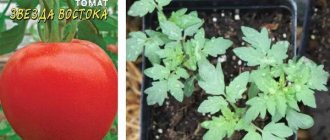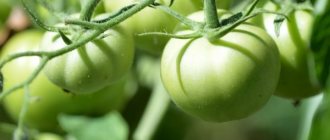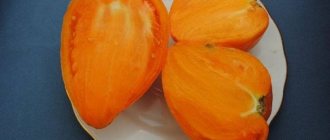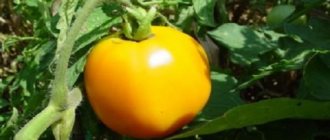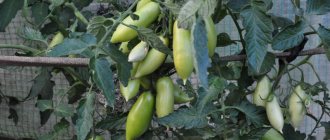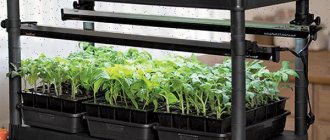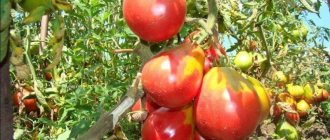Many gardeners and farmers liked the unpretentious and productive tomato Pink Samson F1. Grown in the Central zone, in the northern zones. The hybrid is productive, with high taste and commercial qualities.
| Height | Landing location | Ripening time | Fruit color | Fruit size | Origin | Fruit shape |
| Medium height | Greenhouse, Open ground | Mid-season | Pink | Average | Hybrid | Flat-round |
Description and characteristics of the tomato variety Pink Samson F1, its yield
A frequent visitor to country garden beds is the Pink Samson F1 tomato.
The unpretentiousness of the plant contrasts gently with the delicate shade of ripe tomatoes, an unbridled extravaganza of taste hiding under the thin shell of the berry. Juicy Pink Samson F1 tomatoes ripen on neat, low bushes. Undemanding nature and strong resistance to a variety of temperatures allow the variety to be grown anywhere in the vast latitudes of Russia.
Appearance, taste
The unique tomato hybrid Samson was created by a talented breeder from Russia; neat sprouts have already passed quality tests in many European countries, demonstrating to consumers the successful result of active fruiting.
What do the unusual Pink Samson F1 tomatoes look like? Description of the main external components of tomatoes, the root system and structure of the leaves of the plant. The following characteristic distinguishes the fruits from their numerous counterparts of the succulent class:
- pleasant roundness;
- soft shell gloss;
- density of tomato filling;
- an unusual shade reminiscent of deep pink;
- average fetal weight 230-275 g;
- universal taste that can become a bright addition to any dish.
The root system of the plant has a powerful structure that can easily take root on compacted soils. The tomato leaves are large, rich green in color, and are impressively arranged in a slightly drooping state.
The first elements of the delicate inflorescence are laid above the 11th leaf, the subsequent components of future fruiting are formed through 3 greenish plates of plant origin. The inflorescence is classic, simple with 4-9 fruits.
Main points of cultivation
A high level of resistance allows slender tomato stems to survive cracking and blossom end rot without disastrous consequences. Samson's fruits need regular watering and fertilizing with mineral and organic fertilizers.
Successful growth and a rich harvest of appetizing raspberry-colored fruits are guaranteed by some nuances of care procedures:
- When planting, you must maintain a distance of 40 cm between the stems.
- Often, tomato bushes are planted in place of pumpkins, herbs or root crops that have already outlived their productive life.
- The sprout should be in the hole until the first green leaves appear.
- As soon as the tomato seedlings stretch upward, they are carefully planted in the hole, twisting the thin stem into an ornate spiral. The tip should remain in the light.
- Samson tomatoes require systematic watering, fertilizers, thorough loosening, and eliminating the possibility of parasites.
You cannot fertilize the soil with an abundance of chemicals and natural elements; Pink Samson tomatoes belong to a rare class of products that cannot tolerate large doses of foreign additives. A good fertilizer for neat stems of dense bushes is:
- bird droppings;
- cow dung;
- herbal infusions;
- ash;
- mixtures sold in stores for summer residents.
It is not advisable to alternate variations of vitamin supplements; it is better to use one of the subtypes of feeding throughout the entire development of the plant. Tomatoes Pink Samson F 1 also do not tolerate an abundance of moisture; a large volume of water near the roots interferes with the supply of life-giving oxygen.
The generative nature of Samson tomatoes makes it prone to abundant fruiting. The neat branches are usually completely covered with neat balls of ripe tomatoes. Also, a plant of this type has a smaller number of stepsons.
Pink Samson tomato bushes can be grown both in open ground and in the warm walls of a cozy greenhouse. The soil for the future resident of the beds is prepared in the fall; the fruiting process begins in mid-October.
Main features
Pink Rise F1 tomatoes are hybrid, so it makes no sense to collect your own seeds from them; you need to buy bags again every year. Genuine seeds are quite expensive, but it more than pays for itself by the end of the season.
Fruit
A remarkable achievement of selection is the intense pink color of the Pink Rise F1 fruits both outside and inside. The glossy skin of the tomato has a pearly sheen. The color is uniform, without a greenish spot at the place where the stalk is attached. The shape of the tomatoes is almost perfectly round, slightly flattened at the top. The surface is smooth, sometimes with small smoothed ribs.
The tomatoes are a little like artificial ones - they are so smooth, almost the same size. Not too large, but not small either - from 180 to 220 grams, with a minimum deviation from the standard weight of 200 grams.
The taste is the best among hybrid tomatoes. Of course, the pulp is not as sugary as that of large-fruited non-hybrid varieties, but very pleasant, with a predominance of sweetness. The consistency is quite dense, but not “rubbery”. Juiciness is moderate. The purpose of tomatoes is mainly salad.
The fruits are not prone to cracking. The elastic skin and strong pulp allow the Pink Rise F1 hybrid to successfully withstand long-term transportation and not rot during storage. This quality is good for personal use and truly invaluable for market sales. Combined with external beauty, the result is an ideal product for trading fresh vegetable products. You can harvest and sell whole clusters; the tomatoes ripen in them at the same time.
Greenhouse bushes
Pink Rise F1 tomato plants stand out for their special quality and powerful leaf apparatus, which works intensively for the harvest. The bush is indeterminate, with continuous growth, without self-limitation in height. It is pinched when the greenhouse ceiling is reached or a month before the end of the season. The stem requires a strong garter. There is no need to attach each tomato bunch separately; there are no creases.
Despite the rather dense bush, the Pink Rise hybrid is able to withstand even a slightly thickened planting - 60x40 cm, but only in greenhouses with an ideal climate - without dampness, with good lighting and ventilation; intensive feeding will also be required. This is more suitable for industrial greenhouses.
Harvest
The description of the hybrid variety Pink Rise F1 in the State Register mentions its yield at 5.3 kg per square meter. As a rule, the actual harvest from such an area is an order of magnitude greater: one and a half to two buckets of tomatoes. They depend little on the weather outside the greenhouse and are stable over the years. This hybrid is valued by many gardeners for such reliability.
In terms of ripening time, Pink Rise F1 belongs to the category of mid-ripening. The ripening of the first fruits begins 95–100 days after emergence. Mass yield of the crop occurs from 115 to 120 days. In a good greenhouse, fruiting can be very long, like other tall tomatoes.
From the photo of the bush and reviews of the Pink Rise F1 tomato, you can understand the reason for its popularity among amateur vegetable growers: the plants are hung with spectacular fruits. Having tested this hybrid, greenhouse owners are satisfied with both the quantity and quality of tomatoes. However, it is rightly noted that a decent tomato harvest is a consequence of proper care (regular feeding, watering, pinching).
Tomato Pink Bush F1: reviews, photos of the bush, description, yield, advantages and disadvantages of the variety
Bush dimensions
Today, low-growing varieties of tomatoes are the most common inhabitants of summer cottages. This is due to their unpretentiousness and ability to withstand hot summer weather, especially in the regions of southern Russia. Despite the fact that such varietal shrubs can boast of truly large fruits quite rarely, low-growing tomatoes often have good or high yields. This also includes Pink Bush.
It is worth noting another important quality of this variety. According to the manufacturer's description, the Pink Bush tomato is a determinate hybrid. Professional vegetable farmers certainly know what this characteristic means on the packaging. Those who hear this term for the first time will probably be interested to know that this means that the variety is limited in growth by its own flower cluster.
The shoot of such tomatoes grows until a fruitful ovary appears at its top. The flowering shoot no longer grows; further development of the tomato bush occurs from the most viable stepson, making determinate varieties a real boon for small greenhouses or a summer cottage of six acres.
Tomatoes Pink Impression: variety description
Early ripening (90-95 days from germination to fruiting), indeterminate, tall tomato hybrid. Recommended for growing in greenhouses.
Bush 1.6-1.8 meters high, medium-sized leaves, dark green. The inflorescence is simple. 6 fruits are formed in the brush. The best results were obtained when forming a plant with 2 stems.
The fruits are round, smooth, rich pink in color at maturity, weighing 120-125 grams, excellent (for a hybrid) taste. These tomatoes are good for both fresh consumption and canning. For fresh consumption, allow the fruits to ripen completely on the bush.
Productivity: 3-4 kg of fruits per plant (with proper agricultural technology).
The tomato is not affected by late blight due to its high precocity and produces the main harvest in the first month of fruiting.
Originator: agricultural company Gavrish.
| Variety name | Pink Impression F1 |
| general description | Early maturing indeterminate hybrid |
| Originator | Japan |
| Ripening period | 60-62 days |
| Form | Flat-rounded |
| Color | Pink |
| Average weight of tomatoes | 200-240 grams |
| Application | Universal |
| Productivity of the variety | 9 kg per bush |
| Features of cultivation | Standard agricultural technology |
| Disease resistance | Resistant to major diseases |
Pink Impression F1 is an indeterminate tomato with very early fruiting. The first fruits ripen on the plant 2 months after planting the seeds. It is this property of the hybrid that allows it to be grown in the harshest conditions by direct sowing in the ground. However, the manufacturer recommends growing tomatoes in greenhouses made of film, glass or polycarbonate.
The height of the plant reaches 1.5-2 meters, they do not form a trunk, so they need to be tied to supports or trellises. The hybrid variety “Pink Impression F1” is highly resistant to wilting viruses, spotting, stem cancer and bacteriosis.
- The color of the ripe Pink Impression fruit is pink, quite bright and uniform. At the base of the fruit at the beginning of ripening there is a small green spot, which disappears after 5-8 days.
- The shape of the tomatoes is round, slightly flattened at the poles.
- The seed chambers are small, with an average amount of seeds and liquid.
- The number of seed nests in one tomato does not exceed 12 pieces.
- The pulp of the fruit is medium dense, high in dry matter, with a rich sweetish-sour taste.
Characteristics of the variety
Tomato picnic unique is a hybrid. The variety was first bred by Dutch breeders. The taste and appearance have provided this variety with special love from both professional and novice gardeners. Since the plant does not require special care, even amateur gardeners can easily grow it. However, most often the plant is grown in industrial greenhouses.
Looking at this variety in more detail, it is necessary to understand that high yield is not the only distinguishing characteristic. As you know, many varieties, both hybrid and not, have fairly high yields. And therefore, it cannot be said that “Picnic Unicum F1” is unique in its kind in terms of productivity. Because this is not a completely true statement.
The variety belongs to the mid-season category. This classification into a certain category is explained by the fact that the first fruits appear 120 days after germination.
Cultivation, characteristics and description of the Pink Paradise tomato variety
Reading time: 7 minutes
Sweet juicy tomatoes attract the attention of those who like to diversify their menu with tasty and healthy food. Among the varieties of this crop, you should pay attention to the Pink Paradise tomato, which came to Russia from Japan. This is an indeterminate hybrid that produces a high yield of large pink fruits. Easy care and excellent characteristics have made it popular among vegetable growers.
Description and characteristics of Pink Paradise tomato
A detailed description of the tomato includes the following characteristics:
- indeterminate mid-season hybrid F1;
- original origin: Japan;
- fruit shape is round;
- pink colour;
- ripens in 100 days;
- fruit weight - 150-200 g;
- table variety;
- yield - 2 kg/s bush.
The bush is 2.5 m high, heat-loving, grown under cover or in greenhouses. The fruits weigh up to 200 g. Sweet, pleasant taste, juicy, fleshy core. The skin is dense and does not crack. After ripening, the color is pink without a green border at the stalk. Mid-season tomato varieties ripen 75 days after the seedlings are moved to the ridges.
Pros and cons of a hybrid
The Pink Paradise hybrid has gained popularity among vegetable growers. It has a number of advantages due to which gardeners choose it for growing.
- High yield.
- Early maturation.
- Great taste.
- Easy to care for.
- Immunity to cold.
- Persistent immunity to diseases.
The disadvantages of Pink Paradise include the abundant growth of stepsons and leaves, the need to remove them and form a bush.
Subtleties of growing crops
Early ripening Pink Paradise tomatoes are propagated by growing seedlings. It takes at least 100 days for them to ripen. Sow the seeds no later than mid-March, so that young plants can be planted in the greenhouse in May.
We grow seedlings
To obtain high-quality Pink Paradise tomato seedlings, you must follow the following rules:
- prepare special soil;
- choose healthy mature seeds;
- create favorable conditions for plant development.
Pink Paradise tomato seedlings are grown in a warm room; before transplanting into the ground, they are hardened off by moving them to a cool place.
Soil requirements
The composition of the soil is very important for the proper development of the plant. The soil should be nutritious and loose. It contains peat, turf soil, and baking powder. This is usually sand; when preparing a planting mixture at home, vermiculite is added instead of sand.
Soil can be bought at the store. Garden centers offer a large selection of mixtures that are enriched with humus or sapropel. The nutritional value of such soils is high; it is important that they do not contain larvae of harmful insects and disease spores.
When to plant
It depends on the region where the crop grows. The mid-season hybrid Pink Paradise is grown in a greenhouse, which means that for the middle zone the time for planting seedlings in the ground will be mid-May. Subtracting from the planting date the age of the seedlings when they can be replanted (50-55 days), we get the time for sowing the seeds - mid-March, you can shift the date until the end of the month.
Planting and caring for seedlings
To grow seedlings, use shallow bowls with nutrient soil, diapers or snails, and peat tablets. Most often they are planted in containers 7-8 cm deep, which should have holes to drain excess liquid from irrigation.
The soil is spilled with hot water or Fitosporin solution for disinfection. The finished seeds have already been processed; they do not need to be soaked; they can be spread dry on moist soil. Sprinkle a 1.5-2 cm layer of soil on top and compact slightly. They make a mini-greenhouse by covering the bowls with film. Tomatoes need a temperature of 25 degrees to germinate.
It takes 5-7 days for the seeds to germinate. Next, they are moved to a bright place, the temperature is reduced to 15 degrees. The film is removed gradually, allowing fresh air into the sprouts. After 2 true leaves appear, the seedlings are planted in separate pots.
Subsequently, the plants are carefully watered as the surface layer of the soil dries. They feed with Agricola and Kemira fertilizers for tomatoes or prepare a nutrient solution themselves. When the tomato seedlings form 5 true leaves and the time is right, they are transplanted into a greenhouse.
Transfer to open ground
It is not recommended to grow the Pink Paradise tomato in open ground. This is a heat-loving, tall (up to 2.5 m) plant. Requires a high shelter, which is difficult to build.
Transplanting plants into a greenhouse
The transplant is carried out between May 9-15, depending on the ambient temperature. Bushes are planted at a distance of 60 cm from each other. Such placement will provide sufficient nutrition; growing bushes will not shade neighboring plants.
Recommendations for caring for adult bushes
When planting, water is poured into the hole and fertilizer is added; the plants are not watered for the first week. Feeding will be needed when the bush takes root and begins to grow.
Watering and fertilizing
In greenhouses, Pink Paradise tomatoes are watered every 5-7 days. It is preferable to do this rarely and generously. Moisture should penetrate deep into the soil and wet the root ball. It is useful to mulch the soil around tomatoes with straw, hay, and mown grass.
The first feeding is done 10 days after planting and rooting of seedlings. Nitrogen elements should predominate in the mixture. Next, tomatoes need phosphorus and potassium, and small amounts of boron, manganese, and magnesium. It is most convenient to use complex formulations that include all the necessary elements in a certain percentage.
Among organic fertilizers, an infusion of mullein (1:10) or bird droppings (1:20) is used. Organic compounds are used at the first stage of plant development, when green mass is growing.
Stepping and bush formation
The tall Pink Paradise tomato needs to remove the abundantly growing stepsons. The plant is formed into one or two trunks, all stepsons are removed in their infancy. It is allowed to leave one side shoot formed under the first flower cluster. Bushes must be tied to a trellis or high stakes.
Tall varieties grown in a greenhouse can grow indefinitely and produce a large number of flower clusters. All of them will not be able to ripen, but they will delay the growth and ripening of fruits. At a height of 2 m, the top is pinched, limiting the growth of the bush. Leave no more than 8 flower brushes.
How to grow
Pink Claire is easy to care for, but in order to get a rich harvest, experienced farmers recommend adhering to the rules of sowing, growing seedlings and planting in the ground.
Preparing and sowing seeds
Hybrid seeds do not require a disinfection procedure, but actions aimed at stimulating growth will not be superfluous. The seed material is soaked in Epin-Extra, Zircon, and Immunocytophyte products for 12 hours. Some gardeners prefer natural remedies - aloe and potato juice, infusion of onion peels and ash, honey. This will help shorten the growing season by 2-3 days and increase germination.
Sowing begins in the third ten days of February - the first ten days of March. Any container is suitable for planting seeds: plastic pots, containers, cups, juice or milk tetra packs. The depth of the container should be at least 5 cm, with holes for water to pass through.
The ideal soil for seedlings is a mixture of black soil with peat and sand in a ratio of 2:2:1. Before laying in containers, the soil is loosened and complex fertilizers are applied.
To sow, seeds are buried 2 cm into the soil, watered generously with warm water, and plastic wrap is placed on top.
As soon as the shoots appear, the film is removed and the seedlings are taken out to a windowsill with good lighting, or placed under a phytolamp. The optimal temperature is +20…+25 °C. Water moderately as the soil dries out.
Picking is carried out in large seedling boxes after the appearance of 2-3 true leaves. At the same time, complex fertilizing is applied.
Rules for planting in the ground
Planting seedlings in open soil begins in the third decade of May. A few days before this, they fertilize with mullein and chicken droppings.
The holes are filled with hot water, wait for it to cool and the seedlings are planted. Plants are placed at a distance of 60 cm from each other, since the bushes grow sprawling and require space. Tomatoes do well in soil where zucchini, beans, peas, onions, and garlic previously grew.
The row spacing is 70 cm, the type of arrangement of seedlings is checkerboard. Planting density – 3 bushes per 1 m².
The lower leaves and side shoots are removed. The bushes are tied to supports and formed into two stems.
Bush care and watering
Activities for caring for Pink Claire tomatoes include weeding, watering, fertilizing and prevention of bacterial diseases of nightshade crops.
Weeding is carried out once a week before watering. Weeds draw moisture and nutrients from the soil, so weeding is mandatory.
The bushes are watered no more than 2-3 times a week in the evening so that the leaves do not get burned. In rainy weather, watering is stopped and resumed when the heat sets in.
Moderation of watering is the main condition for obtaining tasty tomatoes. Excess moisture leads to loss of taste. The pulp becomes too watery and tasteless.
Top dressing
Fertilizers are applied regularly, with an interval of 14 days:
- For the first time, take chicken manure diluted in 10 liters of water. Ammonium nitrate, superphosphate and potassium chloride are also suitable.
- The second feeding is carried out using 1 liter of mullein infusion mixed with 25 g of superphosphate and two teaspoons of ash.
- The third fertilizer contains wood ash (3 tbsp), superphosphate (25 g) and manganese sulfate (0.5 g).
- Removal of side shoots is carried out once every 10-14 days.
Characteristics and description of tomato Pink Samson f1, cultivation and planting rules
Tomato Pink Samson f1, the description of which classifies the hybrid as a high-yielding variety, is intended for cultivation in greenhouses. Round tomatoes with a soft shell and dense pulp have universal taste.
Advantages of a hybrid
Tomato Pink Samson f1 belongs to the medium early varieties recommended for cultivation in the first and second rotation for indoor soil. Tomato ripening occurs 90-95 days after emergence.
The characteristics of the tomato indicate a strong root system that actively nourishes the plant even on compacted soils. During the growing season, a strong bush is formed with medium-sized leaves of intense green color, slightly drooping in relation to the stem.
The first inflorescence is formed at the level of 10-12 leaves. 5-8 round fruits are formed in the cluster. At the stage of technical maturity, tomatoes are green, and ripe fruits become pink. The average weight of tomatoes reaches 240-280 g.
The hybrid is resistant to tobacco mosaic virus and bacterial spot. To increase the yield of early products, it is recommended to limit growth after 5-6 brushes. With this method of cultivation, the weight of the fruit is 320 g.
The generative nature of the Samson variety determines the tomato’s propensity for abundant fruiting. Such a plant forms a smaller number of stepsons, and the branches of the bush, as a rule, are completely covered with fruits.
Agrotechnics of cultivation
Tomato variety Samson is grown in seedlings. Before planting in a container with moist soil, hybrid seeds are treated with an aqueous solution of potassium permanganate and a growth stimulator. These procedures ensure friendly shoots.
After 2 true leaves appear, the seedlings are planted in separate containers. It is recommended to use peat pots for this purpose. When transplanting to a permanent place, a space of 50 cm is left between the bushes, and the distance between the rows is 40 cm.
For nightshade crops, it is important to adhere to crop rotation. Beds for tomatoes are arranged after pumpkin crops, herbs, and root vegetables. When planting a tomato, organic fertilizers and wood ash are added to the hole.
The seedlings are transferred to a moistened hole, deepening the sprout to the first true leaf. The stretched seedlings are planted horizontally in the furrow, leaving the top in the light.
When fruits form, the crop requires systematic watering and fertilizing with mineral fertilizers.
The best sources of nutrients are:
- bird droppings;
- manure;
- composts;
- wood ash;
- mixtures of organic fertilizers.
During the growing season, it is recommended to use one of the subtypes of fertilizing.
The soil near the bushes must be loosened periodically to ensure a balance of moisture and air near the root system.
Opinions and recommendations of gardeners
Reviews from vegetable growers characterize the variety as high-yielding, disease-resistant, and note the taste of the tomato.
Mikhail Emelyanov, 52 years old, Balashikha:
“I have been growing tomatoes for many years, so I often plant new species. Last season I cultivated Pink Samson tomato. Germination was excellent, all the seeds hatched. The hybrid is designed for growing in protected ground; despite excellent weather conditions in the summer, the seedlings were placed in a greenhouse. It is important to protect the plant from precipitation. The tomato bush forms a stable stem. The root system is highly developed and provides the plant with nutrients and moisture. The harvest is high, the tomatoes are rich pink in color and taste good. Used fresh and for preparations.”
Irina Savelyeva, 56 years old, Omsk:
“Pink Samson Tomato was recommended by a friend. I grew the plant through seedlings in a greenhouse. The only negative is the inability to grow tomatoes from collected seeds. It is better to buy hybrid planting material at specialized sales points. When cultivating, it is important to adhere to watering norms and apply fertilizing in a timely manner. During the growth process, quite strong bushes are formed, on which bright pink tomatoes ripen. The fruits differ in taste and aroma. They can be used for canning and are very enjoyable fresh.”
Pink tomatoes
Our tomatoes are very popular, recognized for their taste as PINK UNICUM F1, PINK PARADISE F1
. But they have a number of problems - the top and poor resistance to cracking, but if you use calcium nitrate in time and warm up the greenhouse in the morning, then a number of greenhouse growers have been solving these problems for many years.
In recent years, a number of tomatoes have appeared that are more resistant to cracking and topping - these are pink tomatoes AFEN F1, FENDA F1, DIMEROSA F1, PANDAROSA F1, TOMIMARO MUCHO F1, ALESI F1, SENCARA F1
. The most delicious of them is TOMIMARO MUCHO F1
with a refreshing taste.
In 2016-2017, a number of more tomatoes will appear, of which we can highlight the GRIFON F and PINK SAMSON F1
, which have good transportability, resistance to cracking and topping.
If the price of tomato seeds GRIFFON F1
is at the same level as the prices of tomato PINK PARADISE F1 and PINK UNICUM F1, then tomato seeds PINK SAMSON F1 are 3 times cheaper.
For the second whorl, you can use Chinese technology, which consists of pinching the growth point after the formation of the fourth brush. In this case, the tomato ripens quickly and gains more mass. In September and October, temperature differences are very large, and the use of PINK SAMSON F1
reduces the cost of obtaining quality tomatoes.
In addition, this tomato is a semi-generative type; lower greenhouses can be used when growing it. It has been tested in Ukraine and Kazakhstan. There will be a sufficient number of seeds in 2017, and this tomato was developed by a Russian breeder; the production of the seeds themselves is located abroad.
Tomato Pink
Description and characteristics of tomato Pink F1, reviews, photos
Early ripening (90-95 days from germination to fruiting), indeterminate, tall tomato hybrid. Recommended for growing in greenhouses.
Bush 1.6-1.8 meters high, medium-sized leaves, dark green. The inflorescence is simple. 6 fruits are formed in the brush. The best results were obtained when forming a plant with 2 stems.
Basic qualities of fruits
The fruits are round, smooth, rich pink in color at maturity, weighing 120-125 grams, excellent (for a hybrid) taste. These tomatoes are good for both fresh consumption and canning. For fresh consumption, allow the fruits to ripen completely on the bush.
The tomato is not affected by late blight due to its high precocity and produces the main harvest in the first month of fruiting.
The Pink tomato is included in the State Register of the Russian Federation for growing under film covers in private household plots.
Originator : agricultural company Gavrish.
Agrotechnics of cultivation, planting and care
Sowing seeds for seedlings is carried out 55-60 days before the intended planting in the ground. Picking in the phase of the first true leaf. Planting seedlings in the ground in early May. Planting pattern : 40 x 60 cm.
Further care for tomatoes consists of timely watering, fertilizing with complex mineral fertilizer, pinching, weed removal and preventive measures to protect the crop from diseases and pests.
If you grew Pink tomatoes, please write what the yield and taste of the fruit were in your climatic conditions. How do you rate the disease resistance of this tomato? If possible, attach a photo of the entire bush or individual fruits you grew.
Your reviews of the Pink tomato and additions to the description will help many gardeners evaluate this tomato more objectively and decide whether it is worth planting or not.
Tomato care
- "Big Zach" loves water. If tomatoes grow in a greenhouse, they need to be watered every 2-3 days.
- Be sure to fertilize and disinfect against diseases and pests.
- It is better to grow a tomato in 2 trunks - there is a greater chance of a good harvest.
- The tomato should be pruned several times during the season.
- If a tomato grows in a greenhouse, it must be opened for several hours.
- The ideal temperature for good plant development is +22-24 degrees.
- To prevent late blight, it is good to spray the bushes with an aqueous solution of whey (1 liter per 12 liters of water) once every 12 days (after fruit set).
- If the soil is poor, be sure to apply complex mineral fertilizers (according to the instructions) once every 2 weeks.
Features of cultivation and care
Both varieties of Samson are grown in seedlings, they are planted in a permanent place, leaving 50 cm between adjacent bushes, and at least 40 between rows. With this scheme, no more than 4 bushes will be planted on each square meter.
Beds for planting nightshades, in particular tomatoes, are arranged where pumpkin, cruciferous, herbs or root vegetables grew the previous year.
When planting a tomato bush, organic or complete mineral fertilizers are applied to the hole. The sprout is placed in the hole up to the first true leaf.
The elongated seedlings are planted in a hole, carefully twisting the stem into a spiral or furrow horizontally, and the top is left in the light.
